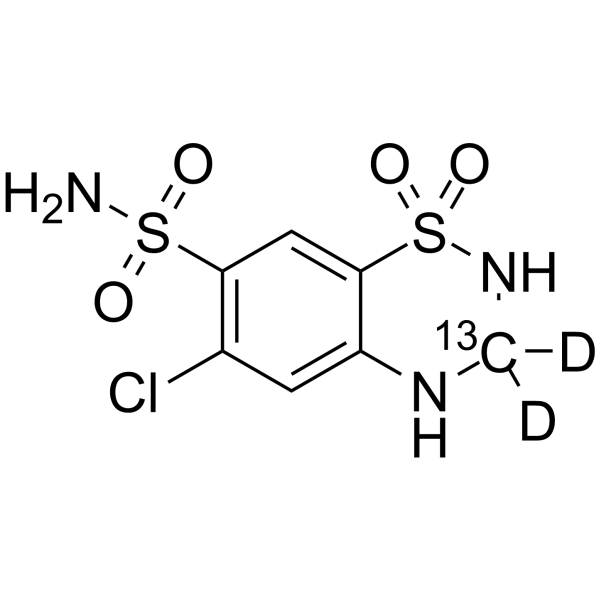Hydrochlorothiazid-13C,d2
Modify Date: 2024-01-29 08:08:23

Hydrochlorothiazid-13C,d2 structure
|
Common Name | Hydrochlorothiazid-13C,d2 | ||
|---|---|---|---|---|
| CAS Number | 1190006-03-1 | Molecular Weight | 300.74 | |
| Density | N/A | Boiling Point | N/A | |
| Molecular Formula | C613CH6D2ClN3O4S2 | Melting Point | N/A | |
| MSDS | N/A | Flash Point | N/A | |
Use of Hydrochlorothiazid-13C,d2Hydrochlorothiazid-13C,d2 is the 13C- and deuterium labeled. Hydrochlorothiazide (HCTZ), an orally active diuretic drug of the thiazide class, inhibits transforming TGF-β/Smad signaling pathway. Hydrochlorothiazide has direct vascular relaxant effects via opening of the calcium-activated potassium (KCA) channel. Hydrochlorothiazide improves cardiac function, reduces fibrosis and has antihypertensive effect[1][2][3]. |
| Name | 6-chloro-3,3-dideuterio-1,1-dioxo-2,4-dihydro-1λ6,2,4-benzothiadiazine-7-sulfonamide |
|---|---|
| Synonym | More Synonyms |
| Description | Hydrochlorothiazid-13C,d2 is the 13C- and deuterium labeled. Hydrochlorothiazide (HCTZ), an orally active diuretic drug of the thiazide class, inhibits transforming TGF-β/Smad signaling pathway. Hydrochlorothiazide has direct vascular relaxant effects via opening of the calcium-activated potassium (KCA) channel. Hydrochlorothiazide improves cardiac function, reduces fibrosis and has antihypertensive effect[1][2][3]. |
|---|---|
| Related Catalog | |
| In Vitro | Stable heavy isotopes of hydrogen, carbon, and other elements have been incorporated into drug molecules, largely as tracers for quantitation during the drug development process. Deuteration has gained attention because of its potential to affect the pharmacokinetic and metabolic profiles of drugs[71]. |
| References |
| Molecular Formula | C613CH6D2ClN3O4S2 |
|---|---|
| Molecular Weight | 300.74 |
| Exact Mass | 299.98000 |
| PSA | 135.12000 |
| LogP | 2.97740 |
| Bremil-13C,d2 |
| Aquarius-13C,d2 |
| Hydrex-13C,d2 |
| Hydrochlorothiazide-13C,d2 |
| Diurizid-13C,d2 |
| Drenol-13C,d2 |
| Dichlotride-13C,d2 |
| Thiuretic-13C,d2 |
| Cidrex-13C,d2 |
| Pantemon-13C,d2 |